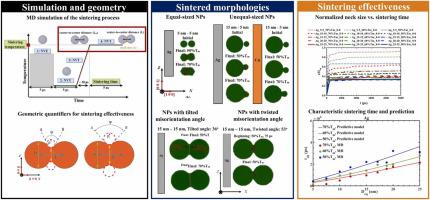当前位置:
X-MOL 学术
›
Mater. Today Commun.
›
论文详情
Our official English website, www.x-mol.net, welcomes your feedback! (Note: you will need to create a separate account there.)
Molecular dynamics simulations of nanoparticle sintering in additive nanomanufacturing: The role of particle size, misorientation angle, material type, and temperature
Materials Today Communications ( IF 3.8 ) Pub Date : 2024-04-13 , DOI: 10.1016/j.mtcomm.2024.108877 Dourna Jamshideasli , Masoud Mahjouri-Samani , Nima Shamsaei , Shuai Shao
Materials Today Communications ( IF 3.8 ) Pub Date : 2024-04-13 , DOI: 10.1016/j.mtcomm.2024.108877 Dourna Jamshideasli , Masoud Mahjouri-Samani , Nima Shamsaei , Shuai Shao

|
Additive nanomanufacturing, where nanoparticles (NPs) are generated via laser material ablation and sintered via laser, permits the fabrication of novel electronic devices with adequate flexibility, such as tunable material composition, adjustable sintered state, and a wide selection of substrates—including biodegradable ones—to name a few. The laser energy input often needs to be carefully balanced between achieving adequate sintering and avoiding substrate damage. The sintered state of NPs, a key influencing factor of the resistivity of electronic circuits, depends not only on temperature (the result of laser energy input), but also on NPs size, size ratio, and crystallographic misorientation. While the minuteness of NPs and the transient nature of their sintering (typically within a nanosecond) make direct experimental evaluation of such parameters challenging, the length and time scales are uniquely suitable for molecular dynamic (MD) studies. This study utilizes MD to investigate the sintering characteristics of silver and copper NP doublets at different temperatures and examines the effects of NP size, size ratios, misorientation angle (including both tilt and twist), and material type. A mathematical framework to describe the characteristic sintering time, i.e., time needed for a NP doublet to achieve a given normalized neck size, was proposed based on MD results.
中文翻译:

增材纳米制造中纳米颗粒烧结的分子动力学模拟:颗粒尺寸、取向差角、材料类型和温度的作用
增材纳米制造通过激光材料烧蚀生成纳米粒子 (NP) 并通过激光烧结,可以制造具有足够灵活性的新型电子设备,例如可调节的材料成分、可调节的烧结状态以及多种基材(包括可生物降解的基材) ——仅举几例。激光能量输入通常需要在实现充分烧结和避免基材损坏之间仔细平衡。纳米粒子的烧结状态是电子电路电阻率的关键影响因素,它不仅取决于温度(激光能量输入的结果),还取决于纳米粒子的尺寸、尺寸比和晶体取向错误。虽然纳米颗粒的微小性及其烧结的瞬态性质(通常在一纳秒内)使得对这些参数的直接实验评估具有挑战性,但长度和时间尺度非常适合分子动力学(MD)研究。本研究利用 MD 研究银和铜 NP 双峰在不同温度下的烧结特性,并检查 NP 尺寸、尺寸比、取向差角(包括倾斜和扭曲)和材料类型的影响。基于MD结果提出了描述特征烧结时间的数学框架,即NP双峰达到给定标准化颈部尺寸所需的时间。
更新日期:2024-04-13
中文翻译:

增材纳米制造中纳米颗粒烧结的分子动力学模拟:颗粒尺寸、取向差角、材料类型和温度的作用
增材纳米制造通过激光材料烧蚀生成纳米粒子 (NP) 并通过激光烧结,可以制造具有足够灵活性的新型电子设备,例如可调节的材料成分、可调节的烧结状态以及多种基材(包括可生物降解的基材) ——仅举几例。激光能量输入通常需要在实现充分烧结和避免基材损坏之间仔细平衡。纳米粒子的烧结状态是电子电路电阻率的关键影响因素,它不仅取决于温度(激光能量输入的结果),还取决于纳米粒子的尺寸、尺寸比和晶体取向错误。虽然纳米颗粒的微小性及其烧结的瞬态性质(通常在一纳秒内)使得对这些参数的直接实验评估具有挑战性,但长度和时间尺度非常适合分子动力学(MD)研究。本研究利用 MD 研究银和铜 NP 双峰在不同温度下的烧结特性,并检查 NP 尺寸、尺寸比、取向差角(包括倾斜和扭曲)和材料类型的影响。基于MD结果提出了描述特征烧结时间的数学框架,即NP双峰达到给定标准化颈部尺寸所需的时间。



























 京公网安备 11010802027423号
京公网安备 11010802027423号